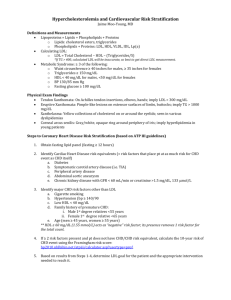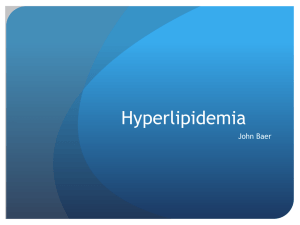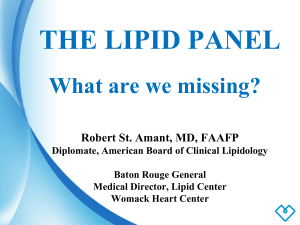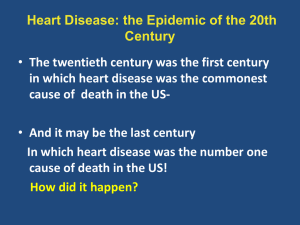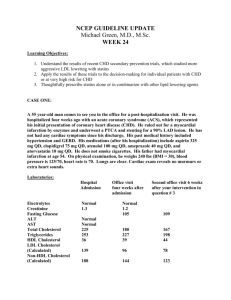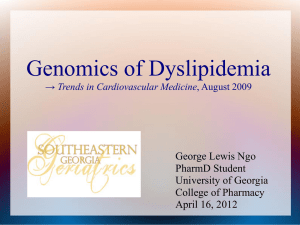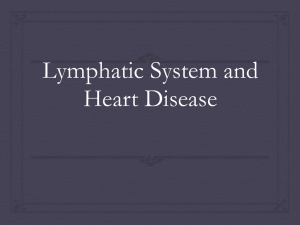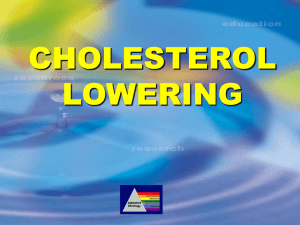Morbidity and Mortality Associated with Hyperlipidemia
advertisement
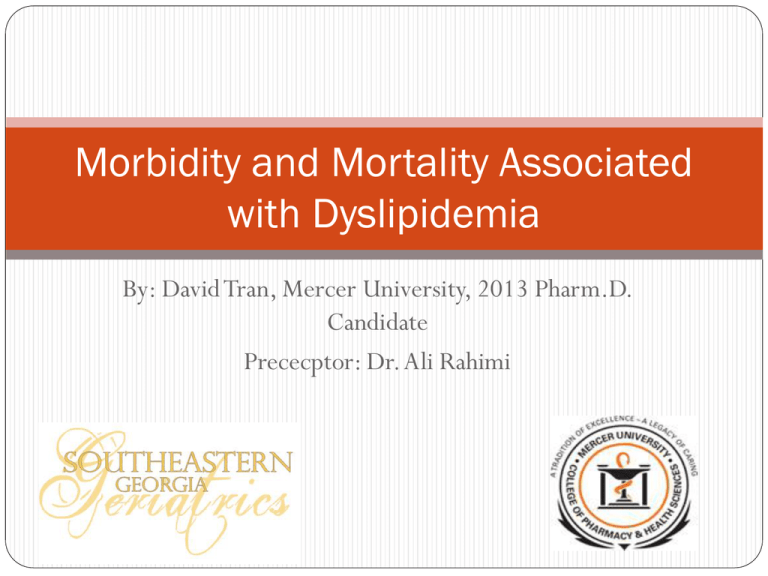
Morbidity and Mortality Associated with Dyslipidemia By: David Tran, Mercer University, 2013 Pharm.D. Candidate Prececptor: Dr. Ali Rahimi Dyslipidemia An imbalance of any or all lipid concentrations in the plasma, including hyperlipidemia, hypertriglyceridemia, and hypercholesterolemia Puts you at risk of developing heart disease which is the leading cause of death in the United States (~620,000 deaths in 2008) People of all ages and backgrounds can have high cholesterol CDC Statistics 71 million American adults (33.5%) have high LDL 1 out of every 3 adults with high LDL cholesterol has the condition under control Less than half of adults with high LDL cholesterol get treatment People with high total cholesterol have approximately twice the risk of heart disease as people with optimal levels. A desirable level is lower than 200 mg/dL The average total cholesterol level for adult Americans is about 200 mg/dL, which is borderline high risk Hyperlipidemia by Ethnicity (LDL >130 mg/dL) Race or Ethnic Background Men (%) Women (%) Non-hispanic Blacks 34.4 27.7 Mexican Americans 41.9 31.6 Non-hispanic Whites 30.5 32.0 All 32.5 31.0 Lipid Goals Total LDL Cholesterol •Desirable <200 mg/dL •Borderline high 200 – 239 mg/dL • High >240 mg/dL Triglycerid HDL es •Optimal •Normal <100 <150 mg/dL mg/dL •Borderline •Near optimal high 100 – 129 150 – 199 mg/dL mg/dL • Borderline high •High 130 – 159 200 – 499 mg/dL mg/dL • High >160 mg/dL •Very high •Low <40 mg/dL •High >60 mg/dL NCEP/ATP III Recommendations Recommend all adults ≥ 20 years old have a fasting lipid panel obtained every 5 years LDL is the primary target TG should be targeted first if TG are >500 mg/dL Once LDL goal is achieved, attention should be focused on other parameters (non-HDL cholesterol) Risk Factors Age: male >45; female >55 Family history: premature CHD in 1st degree relative Male <55; female <65 Current cigarette smoking HTN (>140/90 mmHg or on antihypertensive medications) Low HDL (<40 mg/dL) Abdominal obesity CHD and CHD Risk Equivalents Established CHD CHD Risk Equivalents Myocardial ischemia CAD Stroke history TIA Carotid stenosis >50% MI Coronary angioplasty and/or stent placement CABG Prior unstable angina Peripheral Artery Disease Abdominal Aortic Aneurysm Diabetes Mellitus Dyslipidemia and Coronary Risk Continuous, graded relationship between serum total plasma cholesterol concentration and coronary risk Meta-analysis of 38 primary and secondary prevention trials found that for every 10% reduction in serum cholesterol, CHD mortality would be reduced by 15% and total mortality risk by 11% High LDL levels associated with an increased incidence of CHD in a large number of studies Framingham Heart Study found that the risk of myocardial infarction increases by about 25% for every 5 mg/dL decrement below median values Meta-analysis of prospective population-based studies evaluating the association between serum triglyceride concentration and incidence of cardiovascular disease showed significant risk ratios Lipid Research Clinics Program found that differences of 30 mg/dL in non-HDL corresponded to 19% and 11% increases in mortality in men and women, respectively LDL Target Goals Category LDL goal LDL goal to initiate TLC LDL goal to consider drug therapy CHD or CHD risk equivalents (10 year risk >20%) <100 mg/dL >100 mg/dL >130 mg/dL 2 or more risk factors (10 year risk 10-20%) <130 mg/dL >130 mg/dL >130 mg/dL 2 or more risk factors (10 year risk <10%) <130 mg/dL >130 mg/dL >160 mg/dL 0-1 risk factors <160 mg/dL >160 mg/dL >190 mg/dL Lipid Synthesis Lipid Components Lipoproteins Apo-B48 is required for the formation of the chylomicron and secretion for general circulation Apo-B100 is required for VLDL assembly Lipoprotein lipase (LPL)- forms free fatty acids that can be used for energy in the periphery. Also, responsible for the formation of remnants which is taken up by the liver for breakdown into cholesterol Apo-C2 is responsible for activating LPL Apo-E binds to LDL-related protein receptors for lipids to be taken up into the liver to be broken down into cholesterol and phospholipids Apolipoprotein B Acts as a ligand for LDL receptors in various cells throughout the body to deliver cholesterol High levels of ApoB can lead to plaques that cause atherosclerosis which can thereby lead to heart disease ApoB is a marker for CHD risk The AMORIS study found that measurement of ApoB improved the prediction of fatal MI at all levels of total cholesterol, LDL, and triglycerides In multivariate analysis, the concentration of ApoB was more highly significant than LDL in determining outcomes and added predictive power to LDL cholesterol Apolipoprotein E Serves as a transporter of lipoproteins, fat-soluble vitamins, and cholesterol Variant alleles of ApoE are genetic risk factors for Alzheimer disease Defects in ApoE result in familial hyperlipidemia which is characterized by increased plasma cholesterol and triglycerides Cardiovascular biomarker with a positive dose-response association with ischemic stroke Heart Protection Study Randomized, placebo-controlled trial of effects of simvastatin and antioxidant vitamins on morbidity and mortality >20,536 men and women 40–80 yr at increased risk of CHD due to prior disease with total cholesterol >135 mg/dL Simvastatin 40 mg daily vs placebo Duration of greater than 5 years Heart Protection Study Primary endpoint The effect of simvastatin on total and cause-specific mortality Secondary endpoints Treatment effect on CHD morbidity and mortality in special patient populations Treatment effect on incidence of cancer, strokes, major vascular procedures, and other conditions requiring hospitalization Treatment effect on cause-specific mortality and cancers during longer-term follow-up Heart Protection Study: Vascular Events by Baseline Disease Baseline Disease Simvastatin 40 mg daily (n= 10269) Previous MI 999 (23.5%) Placebo (n= 10267) Other CHD (nonMI) 460 (18.9%) 591 (24.2%) No prior CHD •CVD •PVD •Diabetes 574 (16.1%) 172 (18.7%) 327 (24.7%) 276 (13.8%) 744 (20.8%) 212 (23.6%) 420 (30.5%) 367 (18.6%) All patients 2033 (19.8%) 2585 (25.2%) 1250 (29.4%) Heart Protection Study: Vascular Event by LDL LDL (mg/dL) Simvastatin 40 mg daily (n=10269) Placebo (n= 10267) <100 285 360 100-130 670 881 >130 1087 1365 All patients 2033 2585 References CDC. Vital signs: prevalence, treatment, and control of high levels of low-density lipoprotein cholesterol. United States, 1999–2002 and 2005–2008. MMWR. 2011;60(4):109–14. Khan et al. Apolipoprotein E genotype, cardiovascular biomarkers and risk of stroke: Systematic review and meta-analysis of 14 015 stroke cases and pooled analysis of primary biomarker data from up to 60 883 individuals. International Journal of Epidemiology. 2013 Apr;42(2):475-492. MRC/BHF Heart Protection Study of cholesterol lowering with simvastatin in 20,536 high-risk individuals: a randomised placebo-controlled trial. Lancet 2002 Jul 6;360(9326):7-22. National Institute of Health. Morbidity and Mortality: 2012 Chart Book on Cardiovascular, Lung, and Blood Diseases. Online. 4/16/2013. http://www.nhlbi.nih.gov/resources/docs/2012_ChartBook.pdf Pereira, Telmo. Dyslipidemia- From Prevention to Treatment: Dyslipidemia and Cardiovascular Risk: Lipid Ratios as Risk Factors for Cardiovascular Disease. Pgs 279-298. Roger VL, Go AS, Lloyd-Jones DM, et al. Heart disease and stroke statistics—2012 update: a report from the American Heart Association. Circulation. 2012;125(1):e2–220. Uptodate. Screening Guidelines for Dyslipidemia. Online. 4/10/2013. http://www.uptodate.com/contents/screening-guidelines-for-dyslipidemia?topidKey=PC%
